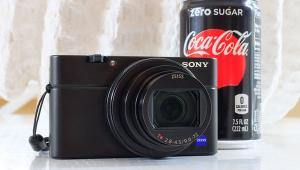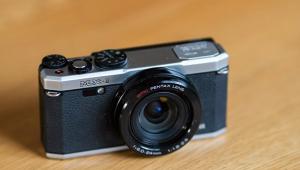DxO One Compact Camera Review

(Editor's Note: Lab Review lab tests and comments are supplied by BetterNet, Shutterbug’s TIPA-affiliated testing lab and edited by George Schaub. Shutterbug is the sole US representative within TIPA, a worldwide association of photo and imaging magazines.)
Since this is from Shutterbug’s Mobile Photography, Apps, and Social Media issue, we’ve decided to take another look at a device that’s designed for all three of those things: the DxO One.
The DxO One is a pocket-sized camera module for the Apple iPhone or iPad that offers a one-inch sensor with 20MP resolution and a fixed focal length of 32mm (35mm film equivalent). The camera uses the iPhone and an app as both the control center and electronic viewfinder.
Reminiscent in functionality of Sony’s QX1, which needs a smartphone and establishes a connection between the camera module and smartphone by Wi-Fi, the new DxO One differs in that it offers a direct hardware connection to the Apple mobile device via the “Lightning” interface. That’s the reason why it can only be used with Apple mobile phones, while the Sony allows use with iOS or Android devices.




Camera Build, Layout & Performance
The camera’s front cover plate has to be pushed down to pop up the “Lightning” port of the camera on its left-hand side, which allows for smartphone connection to the camera. The smartphone starts the DxO camera application automatically.
Hypothetically, the camera can be used with one hand, but we didn’t trust the structural stability of the small “Lightning” male plug to hold the Apple iPhone 6 Plus used for the test: We took all images by using both hands for the camera and smartphone. Nevertheless, the DxO One handling is easier than Sony’s bracket/clip system and Wi-Fi connection. The camera (and the smartphone) doesn’t offer a tripod socket, so for our test images (resolution chart, test box image, dynamic range, and ISO speed test image), which require a stable tripod system, we used a combination of a tripod and some clamps—Cullmann’s Flexx system.
The free camera application allows for use of the smartphone as a very large electronic viewfinder. It offers manual control on focus, exposure settings, and more. Images can be taken by using the virtual shutter release button on the screen or the shutter release button on top of the DxO One. If you are used to shooting images with a smartphone, then setting up this camera by touchscreen operation is very comfortable.
During our tests we had a system crash, which is very, very unusual for a camera. When shooting about 10 Raw images the DxO One started to save the images but didn’t stop or finalize the process. After waiting for 25 minutes and for any further reaction from the camera, we had to use a paper clip to press the very small reset button/hole, located between the microSD card slot and the screw on the rear side of the camera.

Comments on Image Quality
Color: The white balance system of the DxO One causes a rising shift into the yellow area of the color space when recording brighter neutral tones. The test box chart was reproduced with slightly warmer colors. Red nuances are a bit boosted and exaggerated, but skin tones are reproduced very exactly. The overall color performance is very good. Real-life scenes are reproduced with natural-looking colors.
Sharpness: The camera reproduced the test chart with 3,348 of 3,604 lines per picture height, which is a very good result. The image processing system of the DxO One uses an intense sharpness filtering which causes some clipping and overshot effects, so contrast lines may be exaggerated. The test box shot shows an average differentiation of colors in the colored spool. We attributed this reduction of detail reproduction to the fact that anti-noise filtering is in effect at ISO 100. The test image was shot with standard settings: P mode, ISO 100, standard color mode.

Noise: The camera performance in our noise tests was good. The camera keeps luminance noise on a low level. The y-factor keeps below 1.0 percent even at ISO 3200. The color noise is discreet, but beginning with even lower ISO settings, which increases upon raising the ISO speed, the anti-noise filtering gets visible in homogeneous color areas (gray pattern in our test chart). When shooting at ISO 3200 (and higher speeds) the anti-noise filtering gets very aggressive and causes a visible loss of details and contrast lines in the image. At ISO 6400 the gray pattern differentiation becomes nearly invisible. The dynamic range results are on a good level for a compact camera. The DxO One showed a maximum of 9.56 f/stops.

Comments on Video Functions
The DxO One is able to record Full HD video with 1920x1080 pixels. It can record these videos with up to 30 frames per second, while the iPhone 6 Plus, which was used for the test, allows video shooting up to 60 frames. With 60 frames the smartphone is able to reproduce fast-moving objects on the screen and create slow-motion effects.
The DxO uses Apple’s MOV file format and H.264 compression technology for its video recordings. It doesn’t allow setup of exposure or ISO speed settings manually when recording video; it switches directly into the AUTO mode when the user chooses video recording mode on the smartphone screen. That’s why we can only provide one result for our noise and dynamic range test. In our lab tests the AUTO mode caused overexposure so the result chart couldn’t even give a hint of the noise and dynamic range performance of the camera in video mode.

Comments on Video Quality
The camera reproduced sample field shots nicely, although videos that included white walls are reproduced very brightly and were often burned out. Colors look great and are a little warmer than videos made for other camera tests. The color chart was reproduced with the same shift of brighter neutral tones into the yellow direction that occurred in the still image test. The red nuances are very saturated, but all other colors show only minor color errors. When recording videos, the DxO One reproduced skin tones nearly perfectly.
However, the result of the resolution test is a little disappointing. The camera reproduced the ISO 12.233 chart with 683 of 1,080 lines per picture height, which is only an average level for today’s compact cameras. As mentioned above, the dynamic range and noise charts aren’t meaningful because the AUTO exposure mode causes a highly overexposed reproduction of the grayscale pattern.
Scorecard Pros
› Very good image quality for a one-inch sensor system; very good resolution and color results
› Very compact and highly portable
› Control app allows for setup of parameters manually when taking images (note: recording video will switch all back toAUTO mode)
Cons
› Very small status display (only rudimentary setup information)
› Handling sometimes a little awkward; difficult to use with one hand
› Currently iPhone/iPad only; no Android support
The DxO One has a list price of $599. For more information, visit dxo.com.
(Lab Review is where we publish web-exclusive lab reports on cameras. To read more Lab Reviews, click on the Reviews tab on the top navigation bar of this page. New photo gear reports are published frequently, so check Reviews for more equipment evaluations from Shutterbug writers.)
- Log in or register to post comments

















































